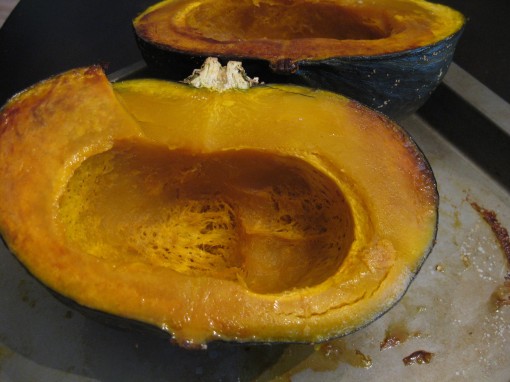When Fall weather starts blowing in, signaling the icy times to come, there is one consolation. Beautiful sweet winter squashes start piling up at the market, where we can pick from an astonishing array of shapes, sizes and colors. The colossal Hubbard dwarfs the petite Sweet Dumpling, while the curvy Butternut lounges provocatively next to the opulent Turban. I love them all, but there is one squash I reach for again and again.
Kabocha.
Sometimes called Japanese pumpkin, the squat, round kabocha is dark green and often streaked with lighter green, but always kind of bumpy. It looks like a buttercup, without the cup, if you know what they look like.
Non-squash lovers don’t understand that there are big differences between squashes. All have their ultimate uses. What I love about the kabocha is it’s dry, fluffy flesh, which is dense and sweet. For making gnocchi, or baking, the lower moisture content is a real benefit. A gnocchi made with wet butternut squash will require too much flour, which will make it tough and mute the squash flavor.
So, the healthy benes of kabocha are basically those of orange vegetables. Packed with Vitamin A, a cup of squash has 145% of your daily requirement. That cup of squash also provides 33% of your C, 25% of your potassium, 24% of your fiber, 24% of your manganese, and 15-to 10% of the b-vitamins Folate, B1, B3, B6 and B5. Eating squash has been linked with lower rates of lung cancer, a healthy prostate, and overall good health.
There are all kinds of ways to prepare a kabocha, but for a beginner, I recommend a simple puree. First, preheat the oven to 400 F, and lightly oil a sheet pan. Using a big chef’s knife, cut the squash in half and scoop out the seeds. If this seems daunting, I have a few tips. First, use the backside of your chef’s knife, the wide, unsharpened side, to give the stem a hard whack. Hopefully the chunk of stem will pop right off, so you can cut the squash easily. If you have a big, hard squash, you can put it in the oven for ten minutes, to soften the skin a bit.
Put the halves, cut sides down, on the baking sheet and bake for 30-40 minutes, depending on the size. When a paring knife slides in with no resistance, take out the squash and let it cool. Use a spatula to turn them over, they will cool faster.
When cool, scoop the flesh into a food processor and puree. You will notice that the squash is so dense it almost bogs down the motor.
At this point you can add some liquid, depending on your desired dish. I like to whip in some miso and orange juice or rice vinegar, and serve it as a side. You might be up for some cream or milk, or stock, to make a quick soup. It’s perfect for simmering with some spices and sweetener for a squash butter, you can use maple syrup or honey, since the squash it already thick. If you want to bake with it, just scrape down and puree.
The thick, sweet kabocha is a treat, however you use it. Enjoy!



I cannot wait to get some…
I’ve got one waiting for the knife right now. MMM